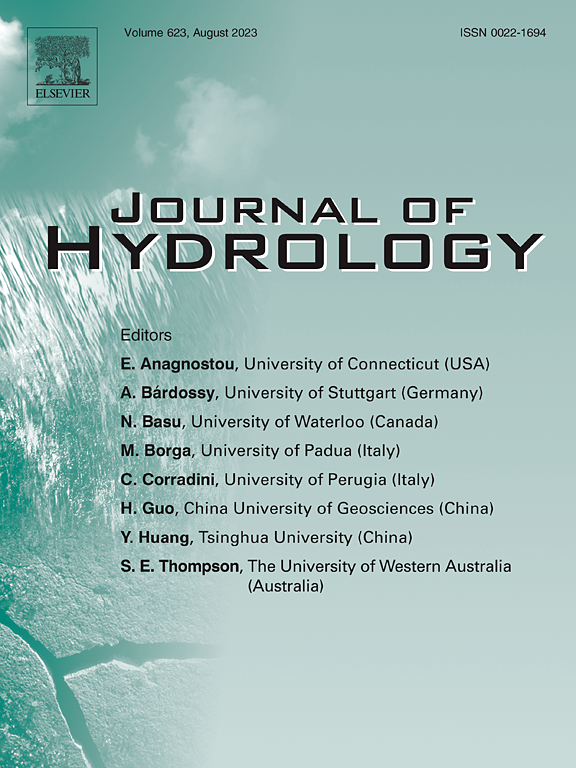黄河流域季节水文过程对植被变化的响应
IF 5.9
1区 地球科学
Q1 ENGINEERING, CIVIL
引用次数: 0
摘要
中国广泛的生态恢复活动对地表水文过程产生了巨大影响。虽然植被变化对水文过程的影响已被充分记录为年度水文过程,但其对季节性水文过程的影响仍然知之甚少。利用新开发的生态水文模型(SWAT-PML),定量分析了植被变化对黄河流域季节水文过程的影响。植被变化引起的水文过程的相对变化在不同季节表现出高度的一致性,与年尺度上的观测结果相似。就整个YRB而言,1998-2020年期间的植被变化导致所有季节的蒸散发增加了~ 8%,径流减少了~ 6%,土壤水分减少了~ 9%,地表径流减少了~ 8%,地下水减少了~ 4%。植被变化对各季节水文过程的相对影响具有空间异质性,与植被变化幅度的空间格局密切相关。这是因为在季节或年尺度上更为明显的植被变化通常对水文过程产生更大的影响。与相对影响不同,水文过程对叶面积指数(LAI)变化的敏感性。即LAI每变化一个单位时水文变量的绝对变化,在不同季节变化很大,敏感性最高的是夏季。然而,与其他季节相比,夏季的相对敏感性(即每单位LAI变化引起的水文变量的相对变化)最低。从空间上看,水文变量对LAI的敏感性在整个长江流域也有很大差异,在更干旱(潮湿)的地区,敏感性更高(更低),这种模式与气候干旱有关。我们的研究结果为理解不同时间尺度上植被变化对水循环的影响提供了有价值的见解。本文章由计算机程序翻译,如有差异,请以英文原文为准。
Responses of seasonal hydrological processes to vegetation change in the Yellow River basin
China’s extensive ecological restoration initiatives have greatly impacted land surface hydrological processes. While the effect of vegetation change on hydrological processes has been well documented for annual hydrological processes, its impacts on the seasonal ones remain poorly understood. Using a newly developed ecohydrological model (SWAT-PML), here we quantify the effects of vegetation change on seasonal hydrological processes in the Yellow River Basin (YRB). We show that the relative changes in hydrological processes due to vegetation change exhibit a high degree of consistency across different seasons, similar to those observed at the annual scale. In terms of the whole YRB, vegetation change during 1998–2020 has resulted in an ∼8 % increase in evapotranspiration, along with decreases of ∼6 % in runoff, ∼9% in soil moisture, ∼8% in surface runoff, and ∼4 % in groundwater across all seasons. However, the relative impacts of vegetation change on each seasonal hydrological process were spatially heterogeneous across the YRB, closely following the spatial pattern of the magnitude of vegetation changes. This is because vegetation changes that are more pronounced at either seasonal or annual scales typically exert greater influences on hydrological processes. Unlike the relative impacts, the sensitivity of hydrological processes to changes in leaf area index (LAI)—i.e., the absolute change in a hydrological variable when LAI changes by one unit—varies substantially across different seasons, with the highest sensitivity occurring in summer. Nevertheless, summer experiences the lowest relative sensitivity (i.e., the relative change in a hydrological variable due to each unit change in LAI) when comparing with other seasons. Spatially, the sensitivity of hydrological variables to LAI also varies considerably across the YRB, with higher (lower) sensitivity in more arid (humid) regions, a pattern linked to the climatic aridity. Our results provide valuable insights into understanding the impacts of vegetation changes on the water cycle at varying temporal scales.
求助全文
通过发布文献求助,成功后即可免费获取论文全文。
去求助
来源期刊

Journal of Hydrology
地学-地球科学综合
CiteScore
11.00
自引率
12.50%
发文量
1309
审稿时长
7.5 months
期刊介绍:
The Journal of Hydrology publishes original research papers and comprehensive reviews in all the subfields of the hydrological sciences including water based management and policy issues that impact on economics and society. These comprise, but are not limited to the physical, chemical, biogeochemical, stochastic and systems aspects of surface and groundwater hydrology, hydrometeorology and hydrogeology. Relevant topics incorporating the insights and methodologies of disciplines such as climatology, water resource systems, hydraulics, agrohydrology, geomorphology, soil science, instrumentation and remote sensing, civil and environmental engineering are included. Social science perspectives on hydrological problems such as resource and ecological economics, environmental sociology, psychology and behavioural science, management and policy analysis are also invited. Multi-and interdisciplinary analyses of hydrological problems are within scope. The science published in the Journal of Hydrology is relevant to catchment scales rather than exclusively to a local scale or site.
 求助内容:
求助内容: 应助结果提醒方式:
应助结果提醒方式:


